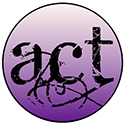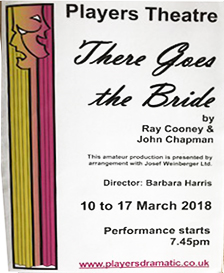Association of Community Theatre

THERE GOES THE BRIDE
by Ray Cooney & John Chapman
directed by Barbara Harris
Players Theatre
 This play written by Ray Cooney and John Chapman tells the story of bride, Judy Westerby (Emily Williams) and her wedding day.
This play written by Ray Cooney and John Chapman tells the story of bride, Judy Westerby (Emily Williams) and her wedding day.
Firstly, can I congratulate Anne Wint on the design of this set. The audience was appreciative of this when the curtains opened. It suggested an opulence by its décor and furnishings, the busts that decorated the room I believe were procured from a local pizzeria. The set had depth and a plethora of doors for characters to use for comings and goings, as any farce should. There was enough space for the director, Barbara Harris, to move characters around with ease, making sure that all performers on stage could be seen at all times.
Not only did Anne design the set, but she choreographed the few brief 1920s dance sections that this play contains. as well as play the role of Ursula, mother of the bride, who wants her daughter’s special day to go without a hitch, and she will do anything for this to happen. This was a confident and assured portrayal of this character as she is challenged by her husband’s apparent infidelity.
At the beginning of the play, the father of the bride, Timothy Westerby (Chris Jorgensson), who works in advertising, devises an ad campaign for a bra company, based on the 1920s icon of the flapper. After a series of bumps to his head, Westerby fantasizes that a cardboard cutout of the flapper girl has magically come to life and is trying to seduce him. As the story unfolds other family members become involved but do not know when, or if, Westerby is talking to them, or relating to his new "girlfriend." These communication mix-ups bring the fun. Chris, has the bulk of dialogue in this play which can be challenging for an actor but Chris coped well, developing a charming character who was excitable and nervous and “on the edge” all the time.
Two great comedy parts were established at the start by Tom Dawson (Dr Gerald Drimmond) and his on stage wife, Margaret Williams (Daphne Drimmond), who were the brides doting grandparents. Tom had great line delivery and timing, as a dotty and forgetful grandfather, who added to the family mayhem, whilst Margaret was the more stoic and acerbic of the two, but equally as comedic. This pair made a great double act.
I have watched Ian Tyler a number of times now and always appreciate the effort he puts into portraying his character, in this case it was as the Best Man, Bill Shorter. Here is a confident actor who understands the script and the character he is playing. Ian engages the audience whenever he is on stage and never lets his performance drop. His expressions indicate to all exactly how he is interpreting every line.
Peter Thorburn was the Father of the Groom, whom we never actually see. He entered the house after a series of phone calls to express his anger and to find out what is causing the hold up for the wedding. His real-life daughter, Meghan Thornburn was the 1920s mischievous flapper girl, Polly Perkins. Both father and daughter gave credible performances in these roles. Although there was very little for Emily Williams (The Bride) to do in this production, she looked and acted the very essence of a bride-to-be, and helped to move the plot along with her timely appearances.
All departments backstage contributed significantly to the development of this play, and director, Barbara Harris must be pleased with the result.